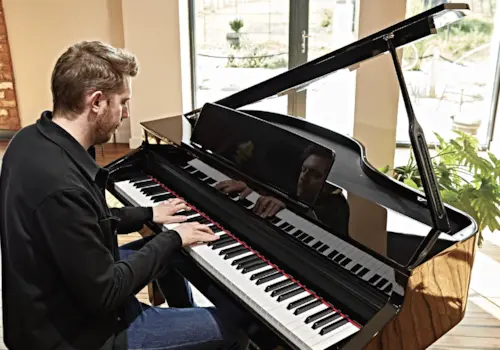This method is certainly unique. Find out how it can help benefit your piano playing
For most of us, this will be the first time that we have come across the Feldenkrais Method™. If you are one of those people, you most likely have a tonne of questions. What is it? Where did it originate from? How can it help me improve as a pianist?
We’re going to try and answer as many of those questions as possible for you.
This lesser-known technique focuses on improving your movement and function through training your mind. Many other posture techniques and methods focus on physical improvement. Focusing on the mind is what makes this method highly unique.
With tonnes of benefits for piano players in particular, including easier and fuller breathing during performances, this is a method definitely worth exploring.
Let’s look a little deeper into what exactly it is…
What is the Feldenkrais Method?
It is an educational method that focuses on improving your movement and enhancing your function, by helping you to pick up on improvements you need to make and implement them effectively.
It is usually taught in both group classes and private sessions. Find out more about the classes here.
It can be compared to the famous Alexander Technique.

The Alexander Technique teachers will first analyse how you currently move before re-training the way you sit, stand, and play
Both methods help to improve posture. The Feldenkrais Method is unique, however, in the sense that it focuses more on ‘flexible minds, not flexible bodies.’ Those are the words of Moshé Feldenkrais, the founder of this method.
What does that mean?
“Well, it means training your mind, and not just your body,” explained Moshé. “Having a healthy mind as well as a healthy body is absolutely critical for any musician.”
What are the benefits for pianists?

Feldenkrais advocator Emma Alter explains in more detail:
"For pianists it can help with postural issues, muscular-skeletal and pain issues, as well as tone production and improved dexterity.
When we use our self in alignment with our physical possibilities, we don't have to use so much force, rather use the body more easily. When we know what we are actually doing, then we can improve what we are doing.
One pianist came to see me as he was finding it difficult to focus when turning a page. When I began to look at how he was moving it transpired that he when he moved any part of his spine, his head moved too (as if his spine was a treetrunk) and then he had to refocus from a very different place, as well as move his eyes to the other side of the music.

Members of the International Feldenkrais Federation work on their posture. © Bob Knighton
Once we had changed his perceptions of how his spine should move – that it should be more of a 'slinky’ – his eye position remained constant as he moved. He could focus more easily on the newly turned page, as well as use his back to create sound more easily from his more moveable spine.
It wasn't that those movements weren't possible, he had just forgotten that they were desirable, and stopped using those options in his movement repertoire. Once we had explored the possibility and talked about his perception of what his spine was able to do, his brain made the changes pretty quickly."
How do I get started?
There are plenty of Feldenkrais teachers available to offer your private lessons. Your other option is to join a class. You can find more information on both here.
Who was Moshé Feldenkrais?

Moshé Feldenkrais. © The Moving Brain
Moshé Feldenkrais was a polymath who had a background in engineering, martial arts, hard science, child development ... and an incredible curiosity.
He realised during his own rehabilitation from soccer injuries that if he paid better attention to what he was doing, he could perform better. The key things to pay attention to were these ideas of how he was using himself; sensing effort and, by contrast, sensing ease; being aware of the feedback and adjusting and experimenting with better ways of performing an action or task.
He famously taught the then Prime Minister of Israel, David Ben-Gurion, to stand on his head at the age of 77.
Feldenkrais refined the method over many decades before he died in the mid-1980s. The method is now being taught in many areas — from health and well-being clinics, through to acting, circus and voice training in many performing arts schools.
Are you familiar with the Feldenkrais Method? Email [email protected] with your thoughts.
Main image: © Christine Barrat, Feldenkrais trainer / Artist Commons







